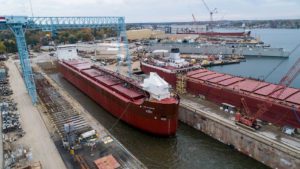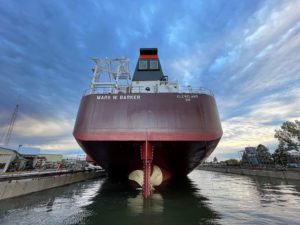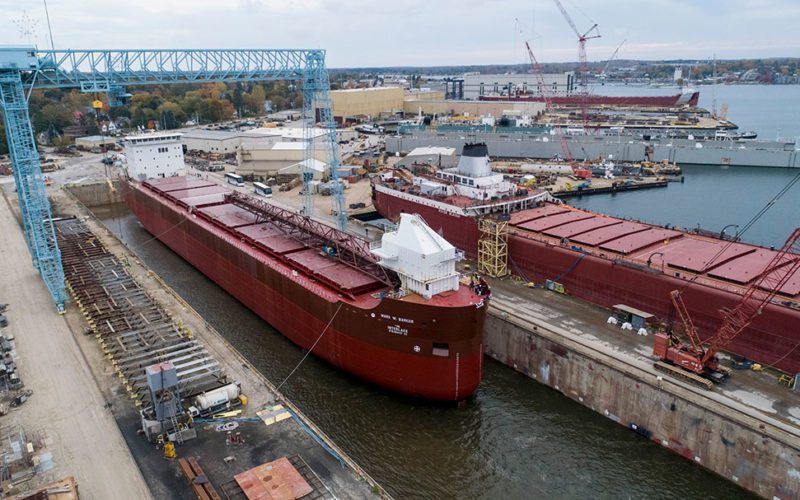
Helen Sharp lifted the ceremonial champagne bottle, held it upright for a moment, then brought it down with a shattering blow.
Applause erupted from hundreds of people, and water from Lake Michigan flowed into the dry dock at Fincantieri Bay Shipbuilding in Sturgeon Bay, Wis. And with that, the first Great Lakes freighter built in the United States in nearly 40 years was formally launched.
The 639-foot Mark W. Barker is the first newbuild for The Interlake Steamship Co. since 1981.The self-unloading ship features a modern, efficient hull design and innovative cargo configuration to accommodate raw materials such as salt and ores, as well as wind turbine parts and other special cargoes.

“This ship was built for service on the Great Lakes,” said Mark W. Barker, the vessel’s namesake and the president of Interlake Steamship Co.
“It will carry all types of cargo throughout the Great Lakes, but it was designed to navigate the tight bends of the Cuyahoga River in Cleveland,” he continued. “If we were going to pick a home port, Cleveland would have to be the one.”
Mark W. Barker is the first Riverclass ship built by Interlake Steamship, a family-owned shipping company based near Cleveland, Ohio, that was founded in 1913. The company operates the largest privately held fleet in the Great Lakes.
The nine-ship fleet includes the 1,013-foot Paul R. Tregurtha, the longest ship sailing on the Great Lakes, and the two 1,004-footers James R. Barker and Mesabi Miner. Mark W. Barker represents an expansion of that fleet, which carries some 20 million tons of cargo each year.
The new ship will be the first on the Great Lakes with engines that meet EPA Tier 4 emissions standards. The propulsion package consists of twin 4,000-hp EMD main engines that turn a single four-blade, controllable-pitch propeller through a Lufkin twin-input, single-output gearbox.
Primary electrical power will come from two 2,500-kW shaft generators connected to the gearbox through power takeoffs. The system will generate enough power for ship’s service and for the 1,000-hp Kongsberg bow and stern thrusters, as well as the cargo unloading system. The ship also has a single 940-kW Caterpillar C32 ship service generator for use when the shaft generators are not in operation, and a 274-kW Cat emergency generator.
The ship was designed by Ian Sharp, Interlake’s director of fleet projects and the husband of honorary launch sponsor Helen Sharp, with critical support from Bay Engineering and Bay Shipbuilding. The hull form was created using the latest concepts for efficiency while underway, including the Kongsberg high-lift rudder with bulb.
“We have worked hard to optimize the wake through the propeller and to have smoother water flow passing across the rudder to make it more efficient,” Barker said.
The cargo loading system represents a notable change compared to most Great Lakes freighters. Mark W. Barker has a square-shaped hold instead of a traditional hold with an angled bottom that funnels bulk cargo onto conveyer belts for offloading.
Interlake said the arrangement creates added capacity for less dense cargo. The unloading boom is located on the forward end of the ship, offering flexibility for cargo operations in congested ports.
“The combination of the larger hatch openings, along with the square, flat-bottomed cargo hold, will also allow us to load and carry large cargo items,” Barker said. “The MacGregor hatches have also been designed to allow deck cargo to be carried on top of the hatch covers.”
Mark W. Barker is the first U.S.-built freighter launched since 1983, and its arrival marks a significant milestone for the Great Lakes maritime trade.
“It says good things about the future of the industry that you have a company like Interlake, that has been around this long, that is willing to invest in the future of the industry,” said Jim Weakley, president of the Lake Carriers’ Association, which advocates for the U.S.-flagged laker fleet.
The U.S. fleet of Great Lakes carriers currently consists of about 60 ships operated by about a dozen companies. Many of those ships are more than 50 years old, thanks to robust annual winter maintenance programs and freshwater lakes that are easier on hulls and critical components than saltwater.
It is too soon to know if the successful Mark W. Barker project will spur similar investment from other American carriers. “I think the other members will take a wait-and-see attitude,” Weakley said. “Everyone tends to let the innovators go first and see what happens.”
The launching ceremony occurred on Oct. 28 at Fincantieri Bay Shipbuilding, which began construction on the new ship more than two years ago. Hundreds of shipyard workers attended the event, along with Interlake employees and their families.
Interlake Steamship Chairman James R. Barker described the launch as a big day for the Barker family, which has a long relationship with Bay Shipbuilding. He dedicated the vessel to the shipyard workers who devoted countless hours to the project.
“Their workmanship and talent are welded into every seam of this vessel,” he said.
Helen Sharp, the ceremonial launch sponsor, formally introduced the ship before breaking the champagne bottle against its steel rail. “May God bless you and all who sail with you,” she said.
The ship floated free in the dry dock later that day. Tugboats towed the vessel to a dockside terminal at the shipyard for final outfitting. Delivery is slated for next spring, in time to begin work during the 2022 Great Lakes shipping season.

